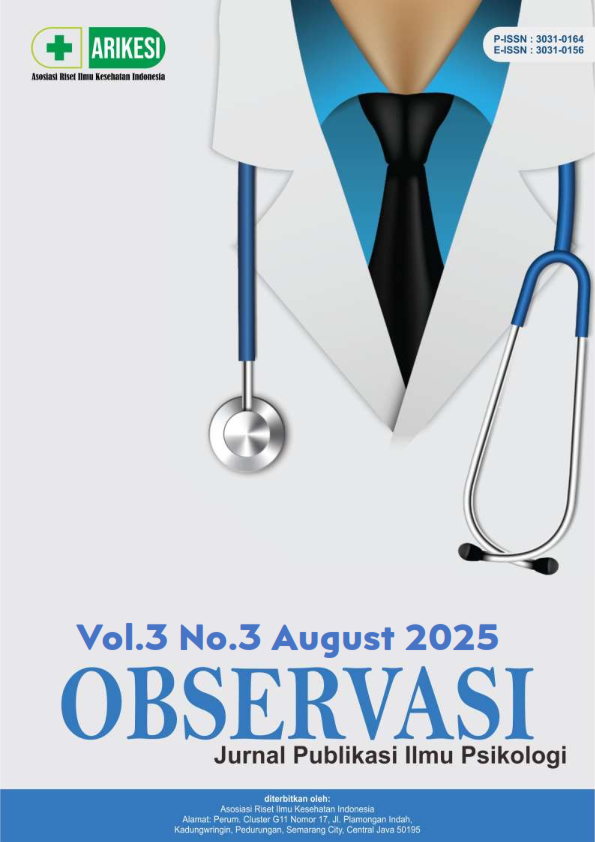Bagaimana Aku Jika Tak Ada Gadget: Efektifitas Digital Detox terhadap Happiness
DOI:
https://doi.org/10.61132/observasi.v3i3.1323Keywords:
Digital detox, generasi z, happinessAbstract
This study aims to examine the effectiveness of digital detox in improving happiness among Generation Z students. An quasi experimental with pretest-posttest control group design. Subjects were psychology students from Padang State University, class of 2021. The results showed that the average gain scores for the experimental (27.6%) and control (7.1%) groups were below the effectiveness threshold (<40%) as defined by Hake (1999), indicating that digital detox was ineffective in enhancing happiness.
Downloads
References
Ames, H., Glenton, C., & Lewin, S. (2019). Purposive sampling in a qualitative evidence synthesis: A worked example from a synthesis on parental perceptions of vaccination communication. BMC Medical Research Methodology, 19(1), 1–9. https://doi.org/10.1186/s12874-019-0660-3
Arieska, P. K., & Herdiani, N. (2018). Pemilihan teknik sampling berdasarkan perhitungan efisiensi relatif. Jurnal Statistika Universitas Muhammadiyah Semarang, 6(2), 1–8.
Atikah, A. R., Fatiya, R., & Andriana, K. (n.d.). When your happiness comes from your social media: Social support dari media sosial sebagai prediktor bagi subjective well-being mahasiswa. Fakultas Psikologi, Universitas Indonesia.
Berezana, O., Krishen, A. S., & Kachroo, P. (2017). The pursuit of virtual happiness: Exploring the social media experience across generations. Journal of Business Research, 89, 455–461. https://doi.org/10.1016/j.jbusres.2017.01.013
Berrocal, P. F., & Natalio, E. (2013). The Subjective Happiness Scale: Translation and preliminary psychometric evaluation of a Spanish version. Social Indicators Research, 119(1), 473–481.
Elfida, D., Milla, M. N., Mansoer, W. W. D., & Takwin, B. (2021). Adaptasi dan uji properti psikometrik The PERMA-Profiler pada orang Indonesia. Persona: Jurnal Psikologi Indonesia, 10(1), 81–103.
Extremera, N., & Fernandez-Berrocal, P. (2014). The Subjective Happiness Scale: Translation and preliminary psychometric evaluation of a Spanish version. Social Indicators Research, 199, 473–481. https://doi.org/10.1007/s11205-013-0493-2
Furr, R. M., & Bacharach, V. R. (2013). Psychometrics: An introduction (2nd ed.). SAGE Publications, Inc.
Gorea, M. (2021). Becoming your “authentic” self: How social media influences youth’s visual transitions. Social Media + Society, 7(3), 1–12. https://doi.org/10.1177/20563051211046984
Graciyal, D. G., & Viswam, D. (2021). Social media and emotional well-being: Pursuit of happiness or pleasure. Asia Pacific Media Educator, 31(1), 99–115. https://doi.org/10.1177/1326365X21995971
Hake, R. R. (1999). Analyzing change/gain scores. Unpublished manuscript. http://www.physics.indiana.edu/~hake
Halimah, D. N. (2020). Studi deskriptif mengenai happiness pada mahasiswa pengguna media sosial di Kota Bandung. Jurnal Roset Psikologi, 1(1), 7–11.
Hartoyo, N. (2020). Pengalaman digital detox pada pengguna sosial media (Skripsi tidak diterbitkan). Universitas Mercu Buana Bekasi.
Khoiriyah, Z. A., & Deni, Z. (2022). Social media detox: An effort to fight social media addiction and the fear of missing out (FOMO). ICHELSS: International Conference on Humanities, Education, Law, and Social Sciences, 2(1), 711–720.
Muhamed, S. M., Lamiaa, S. A., & Fatma, N. K. A. (2021). Effect of detox program on electronic screen syndrome among preparatory school students. Nursing Open, 1–7. https://doi.org/10.1002/nop2.1052
Prasetyo, A. H., Mafruhah, A. T. Y., & Haslinda, N. (2022). Pengaruh penggunaan handphone terhadap prokrastinasi akademik siswa SMKN 1 Sumenep. Jurnal STKIP PGRI Sumenep, 3(1). https://doi.org/10.36379/shine.v3i1.285
Radtke, T., Theresa, A., Konstantin, S., Jan, K., & Eike, V. L. (2021). Digital detox: An effective solution in the smartphone era? A systematic literature review. Mobile Media & Communication, 10(2), 190–215. https://doi.org/10.1177/2050157920984536
Rahardjo, W., Qomariyah, N., Andriani, I., Hermita, M., & Zanah, F. (2020). Adiksi media sosial pada remaja pengguna Instagram dan WhatsApp: Memahami peran need fulfillment dan social media engagement. Jurnal Psikologi Sosial, 18(1), 5–16. https://doi.org/10.7454/jps.2020.03
Rahman, S., Nawal, N., Insani, H. M., & Tobing, E. I. L. (2021). Penggunaan media sosial terhadap kesejahteraan psikologis orang dewasa. Dalam Mempersiapkan generasi digital yang berwatak sociopreneur: Kreatif, inisiatif, dan peduli di era Society 5.0 (hlm. xx–xx).
Ranny, R. (2018). Media literacy for digital natives: Perspective on Generation Z in Jakarta. Jurnal Teknologi Pendidikan, 6(1), 1–206.
Saliha, G. T. C., & Kurniawan, A. (2021). Gambaran authentic happiness pada remaja yang memiliki keluarga broken home. Jurnal Syntax Admiration, 2(12), 2291–2302.
Sampel, P. N. (2005). Teknik sampling. (n.p.).
Syvertsen, T., & Enli, G. (2019). Digital detox: Media resistance and the promise of authenticity. Convergence: The International Journal of Research into New Media Technologies, 25(5–6), 1115–1130. https://doi.org/10.1177/1354856519847325
Tanzer, J. R. (2021). Developing authentic happiness: Growth curve models to assess lifelong happiness. The Journal of Positive Psychology, 16(1), 11–19. https://doi.org/10.1080/17439760.2020.1725605
Vally, Z., & D’Souza, C. G. (2019). Abstinence from social media use, subjective well‐being, stress, and loneliness. Perspectives in Psychiatric Care, 55(4), 576–583. https://doi.org/10.1111/ppc.12431
Winarno, S. (1985). Pengantar interaksi belajar mengajar dasar dan teknik metodologi pengajaran. Bandung: Transito.
Downloads
Published
How to Cite
Issue
Section
License
Copyright (c) 2025 Observasi : Jurnal Publikasi Ilmu Psikologi

This work is licensed under a Creative Commons Attribution-ShareAlike 4.0 International License.





